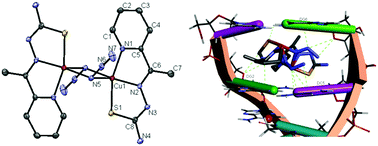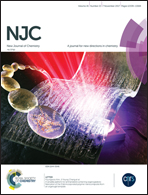One new azido bridged dinuclear copper(ii) thiosemicarbazide complex: synthesis, DNA/protein binding, molecular docking study and cytotoxicity activity†
Abstract
One new azido bridged dinuclear copper(II) thiosemicarbazide complex, [Cu(L)2(N3)2] (1), has been synthesised from the Schiff base ligand derived from 2-acetyl pyridine and thiosemicarbazide. Complex 1 is characterised by elemental analysis, IR, UV-Vis, ESR spectroscopy, cyclic voltammetry and single crystal X-ray structure analysis. Crystallographic results show that the ligand (HL) is coordinated to the metal in a uninegative tridentate fashion. The DNA binding properties of copper(II) complex 1 are explored by employing UV-vis, fluorescence spectral methods, cyclic voltammetry and also viscosity measurements. In addition, the protein binding behaviour in vitro is studied by multispectroscopic techniques using both BSA and HSA. The cytotoxicity profile of the compound along with a cell line study has also been evaluated. Furthermore, the molecular docking technique has also been used to ascertain the mechanism of action of the complex towards DNA, BSA and HSA. Notably, the in vitro cytotoxicity of complex 1 towards two cell lines (AGS and A549 cancer cells) demonstrates that complex 1 has very good broad spectrum anticancer activity.



 Please wait while we load your content...
Please wait while we load your content...